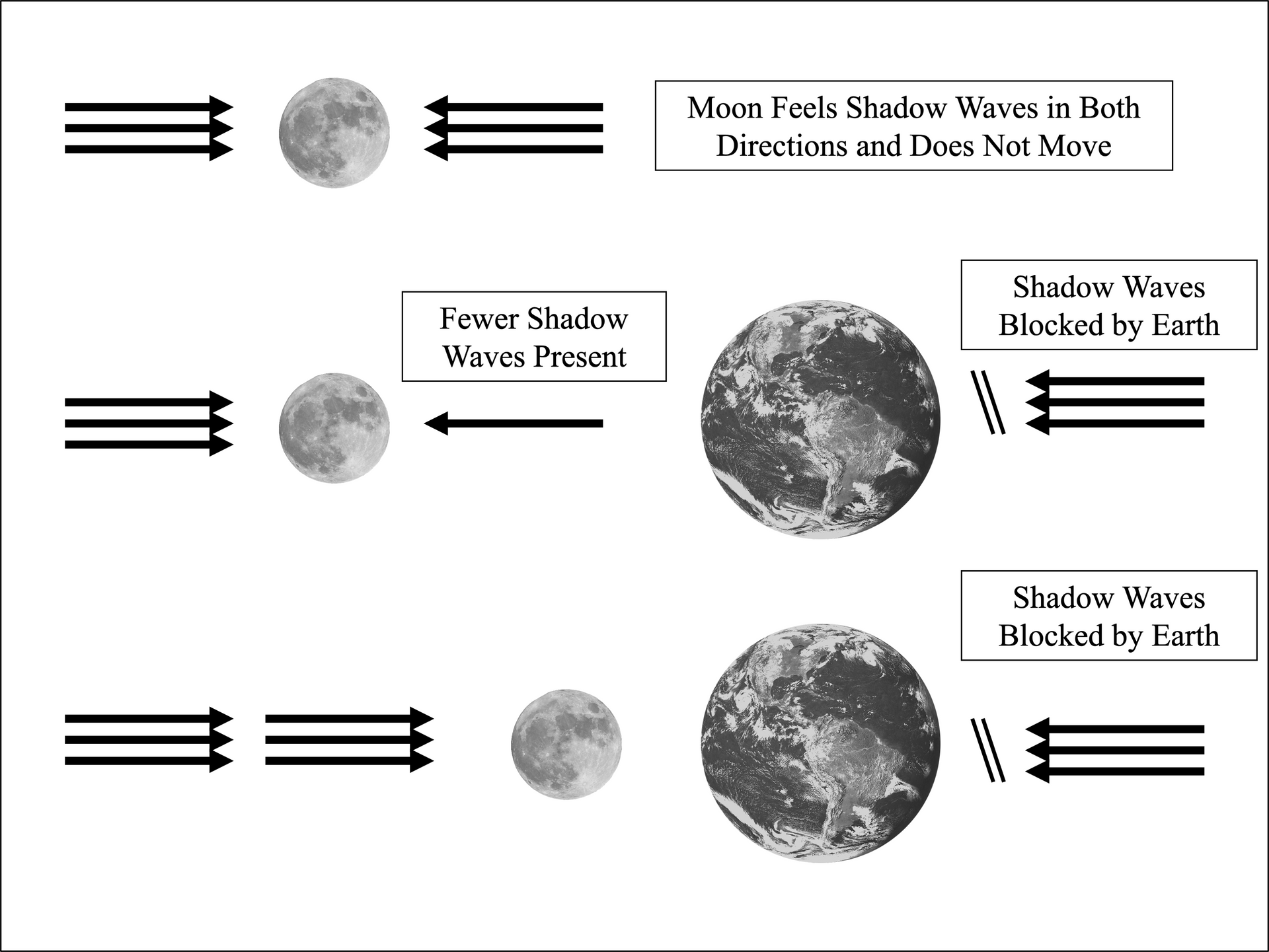Minime Physics
Pilot Waves and Shadow Waves
Introduction to Pilot Wave Theory
Pilot wave theory differs markedly from Newtonian physics, relativity, standard quantum mechanics such as the Copenhagen Interpretation, and other explanations of nature. The concept was first proposed in 1918 by Louis de Broglie, a French graduate student in physics who is best known for his fundamental contribution to the early development of quantum mechanics; namely, that electrons exhibit dual particle and wave features. However, de Broglie also proposed a nascent version of pilot wave theory, consisting of an underlying wave-based structure to the universe that had explanatory and predictive power for several observations in the newly developing field of atomic physics.
The theory was then taken up and significantly advanced by David Bohm in the mid-1900s who published an article in 1952 entitled, A suggested interpretation of the quantum theory in terms of “hidden” variables. Bohm’s version is a less unusual and more intuitive explanation of atomic physics data than QM and was intended to solve some of the problems associated with the Copenhagen Interpretation. Pilot wave theory includes complete mathematical formalism that describes and predicts atomic behavior equally as well as standard quantum mechanics.
According to Bohm, atoms and particles are guided by pilot waves based on two key equations. The first one is analogous to the Schrodinger equation, which describes the wavefunction, and the second is called the Guiding equation, which describes and predicts how particles move on the waves. Pilot wave theory is deterministic, non-local, asserts that particles exist in nature with a definite location irrespective of measurement, and includes hidden variables.
Bohm himself was circumspect and uncertain as to whether pilot waves actually existed in nature, or if they were only mathematically useful constructs. Today, the physical nature of pilot waves, if they exist, remains an open question and a subject of theoretical development and experimental testing. To be sure, though, the impressive mathematical formalism of Bohm in the quantum realm makes expansion of pilot wave theory into areas beyond atomic behavior a serious and legitimate undertaking.
For additional information and to fully appreciate the richness of de Broglie’s and Bohm’s work, one should read their original papers and subsequent follow-up and related articles, including a 2023 review by C. Dewdney in the journal Foundations of Physics.
Introduction to Shadow Wave ‘Theory’
The concept of shadow waves expands upon pilot wave theory and is a helpful scientific teaching tool, a foil with which to compare ideas and concepts, and importantly a toy physics model with which to have some fun.
Time to play
Ready?
Shadow wave ‘theory’ is an idealized model of nature that works via waves and the casting of shadows. The concept embraces a mechanistic explanation of the universe, following on from the early ideas of gravity from Fatio and Le Sage, and many subsequent wave-based models developed since then. It’s a worldview that says the engineering ways and means of nature matter, too – they are the opposite side of the coin to mathematics and abstract theory. Shadow wave theory does not seek unity through a single, all-encompassing equation; rather, it imagines unity through a single all-encompassing mechanism.
Shadow waves and objects
But please understand that shadow wave theory as presented here is not serious science. Instead, the presentation is meant to get you thinking more deeply about nature. The concept and thought experiments are meant to be light-hearted and intentionally naïve, not exhaustive theory or mathematics; more akin to the excited talk among new first-year graduate students in their coffee room, before they are encumbered with an ultra-focused thesis proposal and dissertation committee, when all ideas are still interesting to ponder and open to exploration, and when they are still free to play and connect dots.
Shoshin
Beginner’s mind
The goal is to underscore the peculiarity and non-unified state of the field of physics, as it exists now, versus what a simple and cohesive theory of nature might look like in the future. And in this section, similar to the section on Special and General Relativity, the focus is on time dilation.
Consider the following. Shadow wave theory has two features we will focus on:
1) Objects – Physical entities in the real world such as planets, atoms, and energy.
2) Shadow waves – Large transverse planes of force moving through the universe in multiple directions and angles.
To start let’s consider how shadow waves interact with objects to make things move. A good way to think about shadow waves is like gigantic plates of glass, billions and billions of kilometers across, that are traveling through the universe, except the glass plates are semi-permeable, in other words objects can move through them, although the objects feel a ‘push’ from the waves as they move through. Let’s call them planes or waves but keep the picture of gigantic glass plates moving all through the universe in your mind’s eye.
Stop and think about interacting with one of these shadow planes for a minute, let’s say a plane that is coming directly at you. As the shadow plane moves closer you will not initially feel any force; however, once it contacts your body you will begin to feel a push backwards as the plane moves through you. Then, you will feel no force after the plane has passed by, but soon the next plane will arrive and push you backwards a little more, and so on.
If the planes coming from in front of you were the only ones that exist in the universe, then you would indeed start to move backward in your recliner, as the planes push you from the front.
However, if there were also planes coming from behind you then the force of the front and back planes would balance each other out and you would not move (although the molecules inside you would vibrate a little as the planes hit you at slightly different times). And the same goes for all the other planes, the ones hitting you from all conceivable directions and angles.
Good so far?
Now, let’s clarify the term “wave,” which we are using interchangeably with “plane” to describe these gigantic glass plates of force. The planes moving through the universe do not physically exist as undulating waves, like those we all played with as kids swimming in a pool, they are not physically bouncing up and down, that’s the wrong mental picture.
They are more like huge sheets of glass
The term wave in this context is a bit different than the sort of waves you’re used to. The planes are called waves because that is the mathematical description of the amount of force you feel from a plane as you pass through it.
Think about this for a minute. As a plane reaches you the force you feel will initially be small as the thin outer region starts to push you backwards. But then as you move deeper into the plane the density of the force will increase for a short time as you are in the middle, followed by a slow decrease in the force as you exit the plane.
As shown in the Figure below, if you plot the force felt as you move through a plane it produces a wave – none, a little, a little more, a lot, a little less, even less, none, and so on.
So, when we talk about shadow waves, the picture in your mind should be like large planes of force (semipermeable glass plates) moving in many directions and angles, which translate into a wave (and wave equations) when the force is measured and plotted on a graph.

The physical planes of force and the wave equations are opposite sides of the same coin. From here on out we will use the terms plane and wave interchangeably, with plane as the mental picture of the universe, and wave as the corresponding mathematical description of the force generated by the plane.
Please take a second to view and appreciate the wave shown in the Figure. Slow down a bit so you can admire the symmetry, gentle curvature, and simplicity – the essence of our universe.
Beauty in a pure form
Let’s now think about a ball surrounded by these shadow waves of force, which are moving in many directions and angles, as shown in Panel A of the Figure. An individual wave can push the ball when it hits it; however, since there are multiple waves and they are contacting the ball in all directions, they have no net effect on movement.
In other words, since the ball feels the planes coming equally from all sides and angles it stays where it is located (although its molecules vibrate a little, due to the intermittent waves).
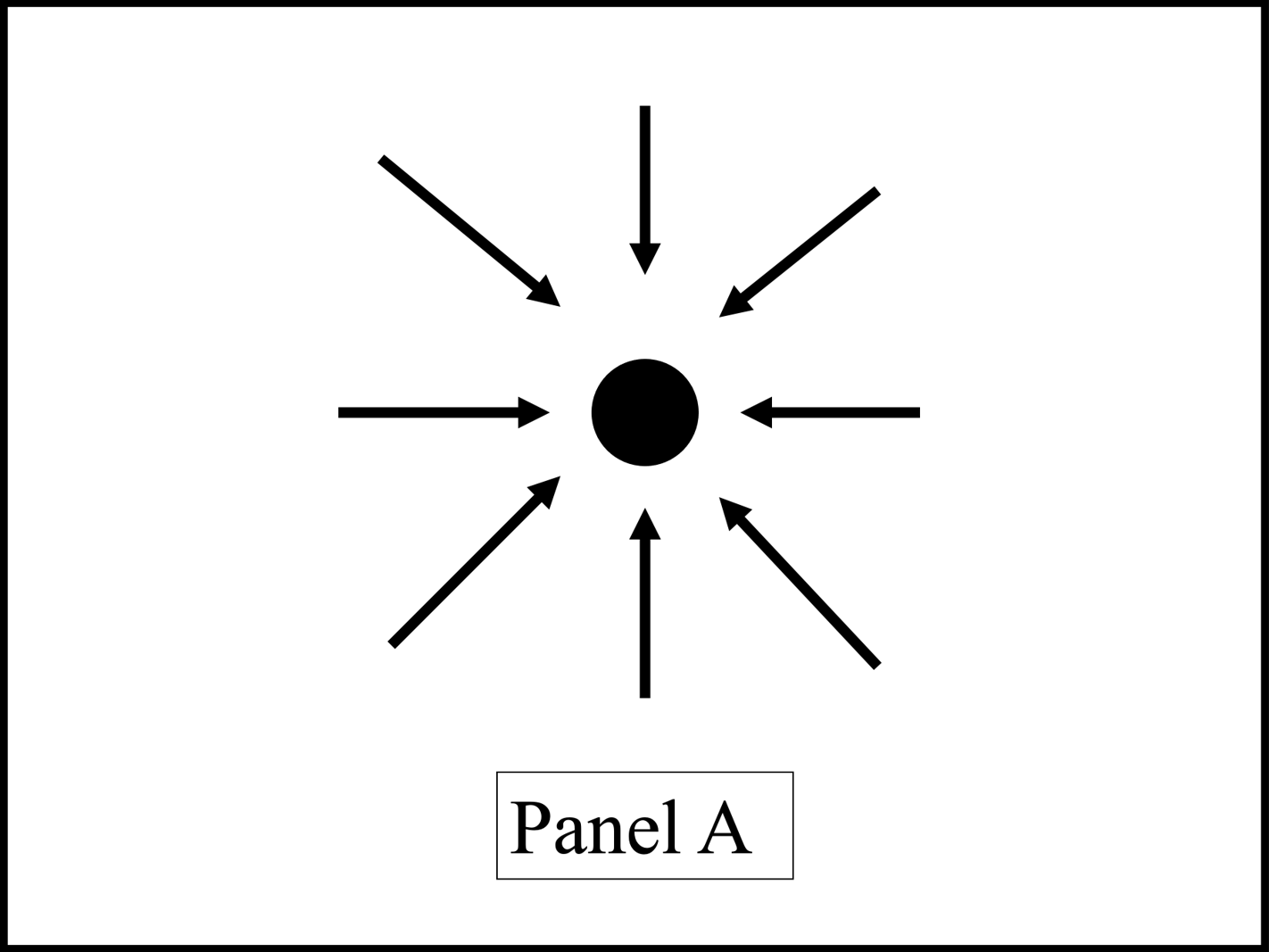
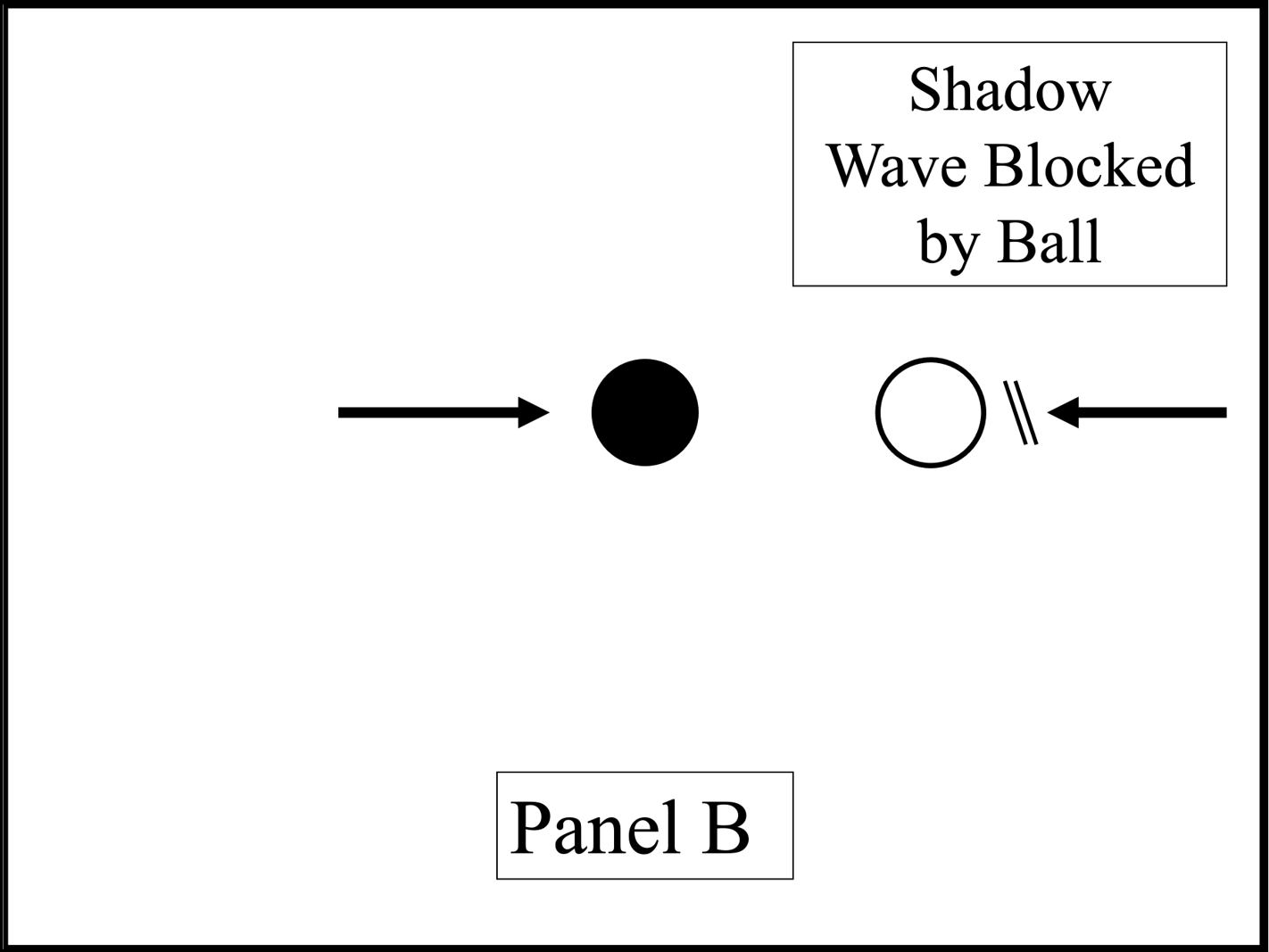
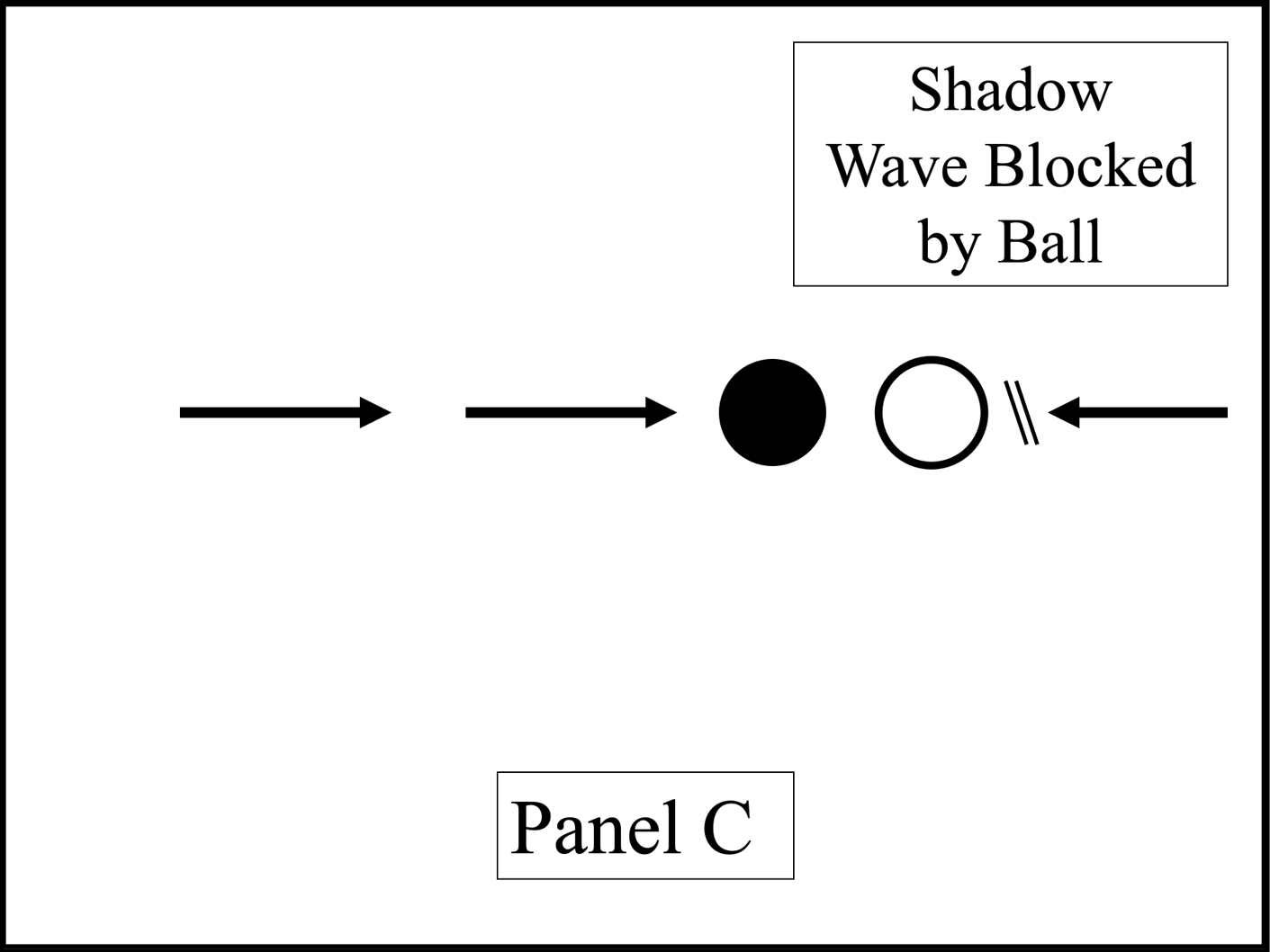
Next, in Panel B consider what happens if you place another object into the picture, a second ball (white object on right), which can block the shadow waves coming from the right side of the page, often called shading in early versions of these sorts of mechanical theories. For simplicity’s sake we will ignore the planes coming from the top and bottom of the page. The black ball will now only feel the waves coming from the left side of the page since the ones from the right are blocked, thus the black ball will be pushed by the waves to the right, towards the white ball, as shown in Panel C.
The white ball casts a ‘shadow’
The black ball seems to be mysteriously attracted to and moving toward the white ball, but it is simply being pushed by the unblocked shadow waves coming from the left side of the page and that is why it moves.
Ok, now let’s think about the earth and moon. How does the earth mysteriously reach out and grab the moon? Let’s use shadow wave theory as a foil, a comparator, and let’s keep the universe as simple as possible.
The answer is that the earth doesn’t reach out and grab the moon, it doesn’t need to, there’s no mysterious attractive force that acts through empty space. Rather, the earth behaves just like the white ball did. It blocks the planes coming from the right, casts a shadow if you will, thus the moon only feels the waves coming from the left and is pushed toward the earth, as shown in the Figure below.
Of course, in reality the two objects both block shadow waves and are pushed toward each other, but for simplicity’s sake we are just considering the effect of the earth for now.
In order to build a serious shadow wave model, one would need to include waves of various wavelengths, intensities, energies, and degree of penetration through objects. Additionally, waves would need to be generated throughout all of space, with some origination points that are static and some that are in motion. But don’t worry about it, too much information.
So, the next time you gaze up at the night sky, ask yourself why the moon does not simply fly away? According to shadow wave theory gravity is not a strange attractive force that reaches out and grabs other objects, nor is it a curving of space as proposed by Einstein in general relativity, nor is it mysterious gravitons or other particles. Gravity is simply the pushing of one object toward another due to shadow waves, the pushing of the moon down toward us on earth due to the planes in the sky aimed in our direction, propelling the moon toward us, and the blocking of the waves in the other direction by the earth, the ones behind us that would push the moon away if not blocked.
As an aside, gravity causes some objects to crash right into the earth, while other objects like the moon go into orbit, which is due to centripetal force (too much information, don’t worry about it).
The point of all this is to use our toy model to encourage you to think more deeply about the mechanism that underlies behaviors in the universe, starting with gravity.
The goal is to encourage you to struggle with and viscerally experience the conundrum of knowing and not knowing, to wrestle with what seems to be such a simple and fundamental concept, gravity, one that many people assume was solved mechanistically long ago, especially given our phenomenal technological achievements of the past century – rockets, moonshots, and the like.
But we need to be careful not to confuse applied science/mathematics, which are directed toward specific technical or numerical goals, with basic science, which is an open-minded exploration of the foundational principles in the universe. Both are wonderful, but they are fundamentally different.
Gadgets versus knowing, calculations versus knowing
It’s important that we all think through the mechanism of gravity, that we ponder, that we struggle. Could gravity be this? Could gravity be that? Would the mathematics work if it were this? How about if it’s that? Are there hints in the experiments we should consider, for example, does light bend as it passes a large object in space (gravitational lensing) due to warped space, or by the blocking of shadow waves by the large object? Are there clues in our observations of nature that will help us understand the mechanism? How do we integrate the equations with the mental picture of what is occurring? Underneath the neat mathematics, intriguing concepts, rockets, and other toys, do we really know how gravity works?
This struggle is the stuff of science and numbers, the cool stuff, the interesting stuff, the fun stuff, the hard stuff. We need to wrestle with gravity, to ponder the questions, to feel the wonder and the angst, because only then will we truly appreciate what we are going to learn about time dilation.
Shadow Wave Theory and Time Dilation
Let’s really have some fun now.
Ready?
Let’s be skeptics and not easily accept that time slows down as described by special relativity. And let’s be like young people and consider this concept anew, naïve, with fresh eyes, and an open mind.
Let’s not know too much.
Let’s be bold and unafraid, like youngsters, and push back against the orthodoxy of special relativity and even against its inventor, the iconic Albert Einstein. And let’s be fearless and a little crazed in our ponderings.
Let’s go!
We will use shadow wave theory as a foil to contrast with the peculiarity of special relativity, as an illustration there are different ways to think about the phenomenon of time. Let’s pry the door open just a bit. The argument here is not that shadow wave theory is necessarily correct; rather it’s a reminder there are alternatives for young physicists to consider.
Time slowing down when we move is a big idea. Big ideas require big skepticism. So, let’s use shadow wave theory to be heretics with special relativity and to have some fun.
Shadow wave theory provides a common-sense alternative explanation for time slowing down due to movement. And it’s very simple. How does time slow down? Easy, it doesn’t, time does not slow down.
But wait.
How can that be? Given what we discussed in the subsection of the website entitled Special/General Relativity, with atomic clocks running more slowly when they are sent into space, how can it be that time does not slow down?
Time does not slow down, only atoms do
To start, let’s stipulate the only kind of ‘real time’ that exists in the universe is the standard one with which we are all familiar, the time that marches along normally at the same rate for everyone in all reference frames.
In other words, time is not bizarre, it does not do weird things, and it does not slow down with movement. Just good, old-fashioned regular time, marching along at the same rate for all of us, no matter our inertial reference frame or our movement.
So, why do clocks slow down when they are sent out to space at a high rate of speed? And why do radioactive elements decay more slowly when moving fast? How do we explain this?
It simply has to do with the forces on atoms. What we see and experience in the world, including how fast our clocks run, is based on how efficiently atom’s function.
Think about it
Everything we see in the universe, including ourselves, the stars, and our clocks are built on atoms, which function based on electrons circulating a nucleus, and the nucleus in turn functions based on the protons, neutrons, and sub-atomic particles interacting with each other. In other words, atoms ‘run’ due to the movement of their parts. And the parts move as fast or slow as the forces applied to them. If the forces on atomic parts decrease, the atoms will run slower, and if the atoms run slower then everything they are part of will run slower, like clocks.
The shadow wave theory explanation is this. Protons, neutrons, sub-atomic particles, and electrons behave like other objects in the universe, like balls and planets. They are pushed around by shadow waves, which is the force that actuates and moves them.
Now, think about what happens to an electron in an atom if you move at a high rate of speed in a rocket ship. The force of the shadow planes on the electron in the direction of motion will get less and less as you speed up, since the atom is traveling along with the waves, as shown in the Figure below.
The force of the shadow planes that is pushing the electron in the same direction of motion, making the electron move, making the atom function, gets less and less. Thus, the atom ‘slows down’ as it moves faster and faster along with shadow waves.
Full three-dimensional movement of the electron is less efficient. And everything that depends on an electron circling the nucleus slows. Clocks. People. Ageing.
And speedometers.
Don’t say it

The same mechanism applies to radioactive decay at high speeds, too. Sub-atomic particles within atomic nuclei are pushed around by shadow planes and experience decreased force in the direction of movement when going fast, thus nuclear processes slow down.
Good old-fashioned time does not slow down as you move faster and faster, it continues normally.
But all objects composed of atoms slow down with movement, everything we can see, touch, and measure.
Think of running on a sandy beach versus running on a track as an imperfect analogy, but one that makes the point. You run slower on the beach because your legs and feet are less efficient than when running on a track, due to the soft sand, you appear to run in slow motion. But time itself has not slowed down, only you have.
In shadow wave theory, space, movement, and time are inextricably linked, in the equations and in the real world, but in an intuitive and mechanical way. Time itself does not slow down. There is nothing strange occurring. And there is no such thing as space-time, just a simple mathematical representation of atomic mechanics with four components.
The point here is to provide an alternative, intuitive explanation of clocks slowing down, as a contrast to special relativity. And to put exclamation points on what must be accepted if special relativity is taken at face value. If you believe in the theory as postulated, then you are left with difficult, troubling, and fundamental questions – what does time slowing down actually mean in the real world? What do we do with this notion? And what in the world is space-time, how do we understand that?
Escape into the numbers?
Just accept the world is weird at high speed?
Be anti-realists and claim that space and time do not exist?
Not think about it at all?
Charles Duell, who was a former Commissioner of the US Patent Office famously said, or perhaps infamously said, “Everything that can be invented has already been invented.” He said this in 1800s. Mr. Duell was not correct. A lot was invented in the past 150 years.
In physics, one can argue the opposite point of Mr. Duell. Most everything foundational has yet to be explained, from gravity, to a mechanism of the invariant speed of light, to much of atomic physics. The future is wide open for the youngsters. Advice given to them in the 1800s, in Mr. Duell’s time, was often, “Go west young man and make your fortune, go west. The prairies and forests are wide open.”
Today, a similar type of advice might be, “Go foundational young man or woman, go foundational. Fundamental physics is wide open.”
General Relativity, Gravity, and Time Dilation
Time also slows down in general relativity.
Just like with special relativity and time slowing with movement, the phenomenon of gravity causing time to slow was validated using atomic clocks. If I am at the top of a skyscraper and you are on the first floor your watch will run slower than mine.
Why?
To provide a simple mechanistic understanding of gravity slowing down time, let’s use our shadow wave toy as a foil again.
We saw earlier that basic gravitational ‘attraction’ can be explained by the blocking of shadow planes by planets and moons, which causes objects to move towards each other due to the pushing of shadow waves from the opposite direction, called gravitational shading.
It is not warped space or a mysterious attractive force, but simply a shadow wave push.
The Figure is shown again just as a refresher.
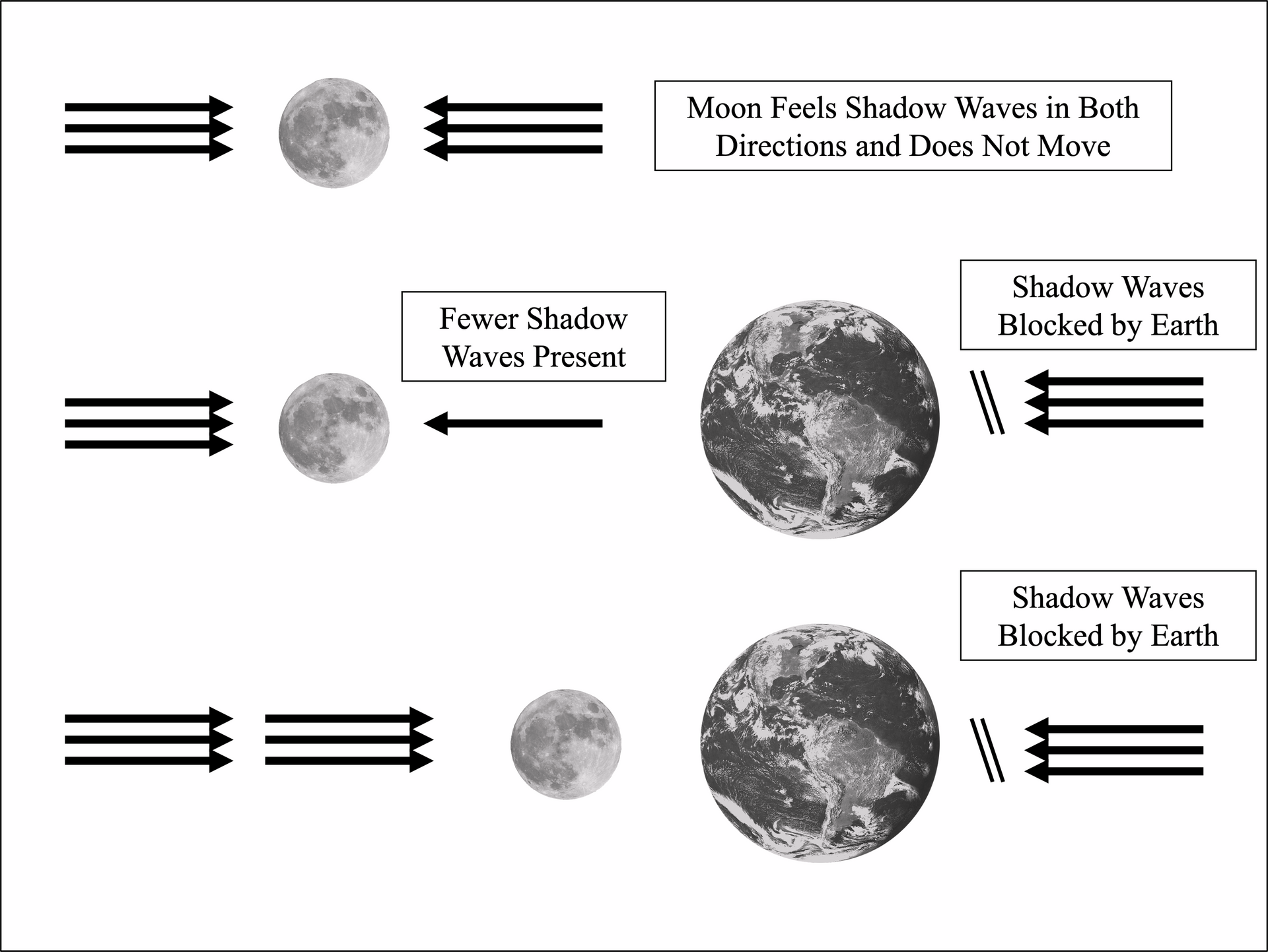
That’s simple and fine for basic gravitational attraction, but how does shadow wave theory explain that gravity can cause time to slow down when you are close to an object?
The answer is simple.
The phenomenon is just like we saw with special relativity, with time slowing down when you move in a rocket ship. In that case, time does not actually slow down, only atoms slow, due to the change in shadow wave force they experience with movement. Clocks run slower because their atoms run slower since the shadow wave force on them in the direction of movement is less. However, good old-fashioned universal time runs along as it normally does.
With general relativity and time, we have a similar mechanism. Time does not slow down, only atoms do. When you are near an object time does not slow down, only atoms do because the shadow planes from behind the object, the earth for example, are blocked from coming through, thus atoms experience less shadow wave force coming from the direction of the blocking object, meaning that electrons and nuclei no longer function as efficiently in three dimensions. Thus, atoms run slower near objects, and everything that depends on them (essentially everything we can see) appears in slow motion. Moreover, the closer you get to the blocking object the stronger the effect, the darker the shadow if you will, the slower things happen, including your watch running slower at the bottom of a building compared to the top.
Time does not slow down due to gravity. Atoms slow down with gravity due to the blocking of shadow waves by objects, with a concomitant change in the force that makes them run in three dimensions.
Future Directions
Further expanding the shadow/pilot wave concepts to explain apparent time dilation in a real-world, three-dimensional object such as a clock is challenging. Clearly, going beyond the highly simplified, idealized explanation presented here will require additional ideas, mathematics, and experimental approaches.
As a starting point for a more thorough approach, one can propose that clocks or other objects slow with motion and gravity at least in part due to the efficiency of three-dimensional electron orbital standing waves; where atoms at rest and not in a gravitational field are subjected to a uniform structure of shadow/pilot waves. In this circumstance constructive interference in electron standing waves is maximized. Subsequent movement of the atom through the shadow/pilot waves or changes in the waves due to a nearby blocking object will alter and disrupt the uniform three-dimensional local wave structure and change parameters of the standing waves. The emergent properties of the system, including standard chemical interactions of atoms and molecular vibrations would be affected in this scenario and events potentially slowed due to the now non-ideal and less efficient state of electrons and molecules.
Although highly speculative, this notion can serve as a beginning to expand the simple idealized shadow/pilot wave interactions to a full three-dimensional standing wave model that considers and accounts for the effect of waves coming from multiple directions and angles.

